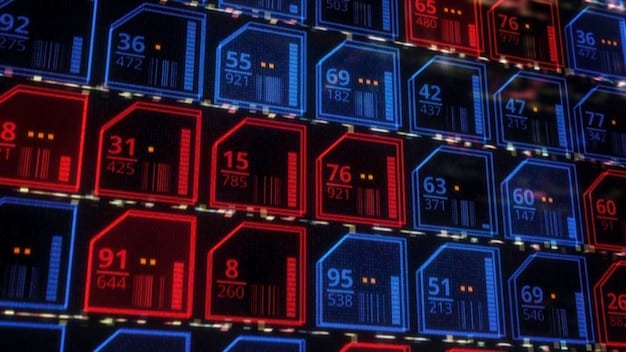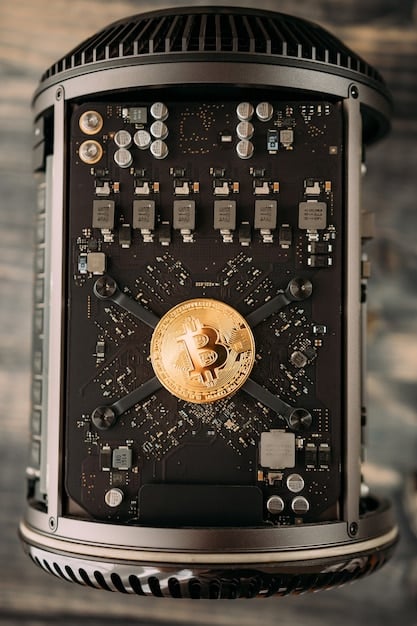Altcoin Mining Profitability in 2025: Hashrates, Energy, and ROI

Altcoin mining profitability in 2025 hinges on factors like hashrate, energy consumption, and ROI, requiring miners to carefully evaluate each altcoin’s potential against operational costs for profitable ventures.
As we approach 2025, understanding the Altcoin Mining Profitability: Comparing Hashrates, Energy Consumption, and ROI in 2025 becomes crucial for both seasoned and novice miners looking to maximize their returns.
Here’s what you need to know:
Understanding Altcoin Mining Hashrates
Hashrate plays a pivotal role in the profitability of altcoin mining. It directly affects the ability of a miner to solve complex algorithms and earn rewards.
What is Hashrate?
Hashrate refers to the computational power used to mine cryptocurrencies. Measured in hashes per second (H/s), it indicates how quickly a mining device can perform calculations.
Hashrate and Mining Difficulty
Mining difficulty adjusts based on the network’s hashrate. Higher hashrates generally lead to increased difficulty, making it harder for individual miners to find blocks.

- Higher Hashrate Needs: Altcoins with popular mining algorithms often require more powerful mining setups.
- Lower Competition Coins: Focusing on altcoins with lower hashrates can increase chances of finding blocks, but this also may indicate lower overall profitability.
- Network Adjustments: Understanding that networks automatically adjust to hashrate totals is essential.
In essence, hashrate dictates how competitive mining an altcoin will be and how frequently a miner can expect to receive rewards.
Energy Consumption in Altcoin Mining
Energy consumption is a significant determinant of mining profitability. Optimizing energy usage is critical for reducing costs and increasing ROI.
Electricity costs can significantly impact a miner’s bottom line. High energy consumption can render even a profitable altcoin unviable.
Calculating Energy Costs
Calculate your energy costs by multiplying the power consumption of your mining hardware (in watts) by the electricity rate (in dollars per kilowatt-hour) and the number of hours in a day.
Efficient Mining Hardware
Using the most energy-efficient hardware can substantially reduce operational expenses. Look into GPUs or ASICs that offer higher hashrate per watt.

- ASIC vs GPU Mining: ASICs are typically more energy efficient than GPUs for specific algorithms.
- Undervolting: Adjusting voltage settings on GPUs can reduce energy consumption without significantly impacting hashrate.
- Cooling Solutions: Efficient cooling can prevent hardware from overheating, which can lead to decreased performance and increased energy usage.
Effectively managing energy consumption is crucial for maintaining profitability, especially as mining difficulty increases.
Return on Investment (ROI) for Altcoin Mining in 2025
ROI is a critical metric for assessing the profitability of altcoin mining. It measures the profitability of an investment relative to its cost.
Evaluate potential altcoins based on their ROI to make informed mining decisions. A higher ROI suggests a more profitable mining venture.
Factors Affecting ROI
Several factors influence the ROI of altcoin mining, including the initial investment in hardware, energy costs, the altcoin’s price, and mining difficulty.
Calculating ROI
ROI is calculated by dividing the net profit (total revenue minus total costs) by the total investment cost and multiplying by 100 to express it as a percentage.
- Hardware Costs: Consider the cost of mining hardware and its lifespan.
- Price Volatility: Account for the impact of price fluctuations on your earnings.
- Mining Pool Fees: Factor in any fees charged by mining pools.
Understanding ROI is essential for determining whether altcoin mining is a worthwhile investment.
Effective assessment of hashrate, energy usage, and ROI ensures sustainable mining, enabling miners to optimize their earnings in the competitive landscape.
Comparing Altcoin Mining Algorithms
Different altcoins use various mining algorithms, each having distinct characteristics that affect mining profitability.
Selecting the right algorithm is crucial for maximizing efficiency and profit. Certain GPUs and ASICs perform better on specific algorithms.
Popular Mining Algorithms
Common mining algorithms include SHA-256, Scrypt, Equihash, and CryptoNight. Each algorithm requires different types of hardware for optimal performance.
Algorithm Efficiency
Algorithm efficiency refers to the amount of electricity required to perform a certain number of hashes. More efficient algorithms provide higher hashrates per watt.
- SHA-256: Bitcoin and Bitcoin Cash use SHA-256, which is primarily mined with ASICs due to its high computational demands.
- Scrypt: Litecoin uses Scrypt, which can be mined using both GPUs and ASICs, although ASICs are more efficient.
- Equihash: Zcash and Bitcoin Gold use Equihash, which is suitable for GPU mining due to its memory-intensive nature.
Choosing an algorithm that aligns with your hardware’s capabilities is essential for maximizing mining efficiency.
Different mining algorithms cater to different hardware, and this choice considerably influences mining efficiency.
Hardware Options for Altcoin Mining
The choice of mining hardware is integral to the success of altcoin mining. Selecting the right hardware can significantly impact hashrate, energy consumption, and overall profitability.
Choosing the right mining hardware can boost hashrate output while reducing energy bills. There are two primary types of mining hardware: GPUs and ASICs.
GPU Mining
GPUs offer versatility and can mine various altcoins, depending on the algorithm. They are more flexible than ASICs but less energy efficient for specific algorithms.
ASIC Mining
ASICs are designed for a specific algorithm, offering high hashrates and energy efficiency. However, they are less flexible and can become obsolete if an altcoin changes its algorithm.
- GPU Advantages: Versatile, cheaper, easier to resell.
- GPU Disadvantages: Lower hashrate per watt, higher energy costs.
- ASIC Advantages: Higher hashrate per watt, lower energy costs.
- ASIC Disadvantages: Expensive, not versatile, higher risk of obsolescence.
Hardware choice hinges on specific algorithms, budget, and mining goals. Evaluating GPUs and ASICs assists in making the right decision.
The efficacy of altcoin mining is heavily influenced by hardware selection. GPUs provide versatility, while ASICs offer high performance.
Future Trends and Predictions for 2025
Several trends will likely shape the future of altcoin mining in 2025. Keeping abreast of these can help miners adapt and stay profitable.
Anticipating new trends may lead to preemptive strategies for adaptation. Innovation, regulation, and technology will shape mining’s future.
Anticipated Changes
Increased competition, advancements in mining hardware, and regulatory developments are among the changes expected in the altcoin mining landscape.
Technological Advancements
Expect more efficient mining hardware and innovative cooling solutions to emerge. Quantum computing and AI may also play a role in optimizing mining operations.
- Enhanced Efficiency: Future hardware will offer higher hashrates at lower energy consumption.
- Regulatory Changes: Governments may introduce new regulations that impact mining profitability.
- Decentralized Mining: More miners may opt for decentralized mining pools to reduce centralization risks.
Being aware of these trends and predictions will enable miners to make informed decisions and adapt to the evolving altcoin mining landscape.
By understanding future directions, and using strategies based on current innovations and regulations.
| Key Aspect | Brief Description |
|---|---|
| 💪 Hashrate | Computational power for mining; higher hashrate increases chances of solving blocks. |
| ⚡ Energy Consumption | Electrical power used by mining hardware; lower consumption means higher profits. |
| 💰 ROI | Return on Investment; measure of an inveestment’s profitability relative to its cost. |
| ⚙️ Mining Hardware | Equipment used to mine altcoins, such as GPUs and ASICs, each with different efficiencies. |
Frequently Asked Questions
Altcoin mining profitability depends on hashrate, energy consumption, ROI, mining algorithm, and hardware choice. Balancing these factors is crucial for a successful mining venture.
Hashrate affects mining profitability by determining how quickly you can solve blocks. A higher hashrate increases your chances but also raises mining difficulty overall.
Hardware options include GPUs and ASICs. GPUs offer versatility while ASICs provide higher efficiency for specific algorithms, impacting profitability differently.
ROI is calculated by dividing net profit by the total investment and multiplying by 100. It indicates return on initial investment, less operation costs.
Energy consumption plays a vital role as it increases operational costs. Lowering energy consumption can significantly improve overall mining profit.
Conclusion
Navigating the complexities of altcoin mining profitability in 2025 requires a strategic approach, balancing hashrate, energy consumption, and hardware selection. Keeping abreast of technological advancements and regulatory changes will further enhance viability in the dynamic cryptocurrency landscape.





